![]()
![]()
(An effort at deciphering the letters by his
great-grandson Eric Blackwell)
Last update 4/20/2008 - This is very much
a "work-in-progress" (and a labor of love). Each time
I re-read the letters I am able to fill in a few
more of the "blanks" and correct my previous errors.
A few more letters have been located and
"translated" by Betsy Deal Smith with input from many
relatives. These letters will be uploaded to this
website in the next month or so. They are
actually some of the most interesting letters and had probably
been set aside for this reason
at some time in the past, which would explain why they were
not with the larger bundle of letters.
Heartfelt thanks to my Aunt Jodie Brown,
grand-daughter of William Laban Brown and
daughter of Albert Rosecrans Brown, who
provided almost all
of the historical material used on these pages,
and to my cousins Martha Carol Brown Stromberg and Rob
Stromberg
for their continuing diligence after Jodie's death in
preserving the material, with most of the original
documents now in the archives of East Tennessee State
University in Johnson City, Tennessee.
ADDITION August 26, 2018:
My niece Jody Blackwell who is a talented singer-songwriter
was moved by William Laban Brown's
repeated references to his love for the hymn "There Is a
Fountain Filled With Blood" and has
released a moving version of the hymn which, with her
permission, can be heard at this link:
https://music.jodyblackwell.

Detail of a letter from Nancy Colvin Brown to her husband
William Laban Brown
in which she refers to "the ship blowing up that had had left
Vicksburg with some
prisoners on it." The letter was returned to her, for
both her husband and her cousin
David Cusick were among the more than 1,500 people killed in
the Sultana tragedy.
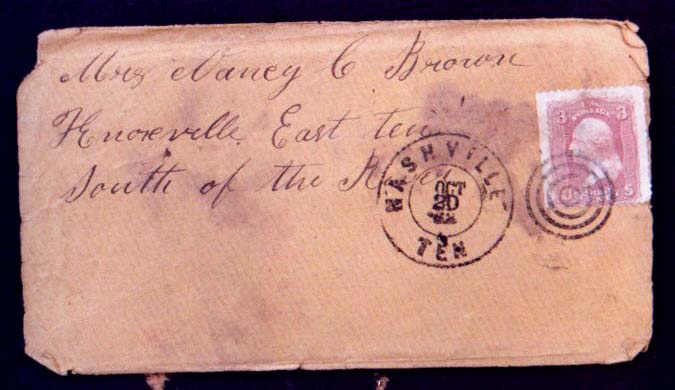
View the letter from William Laban Brown to his wife from mid-October, 1863
View the letter from William Laban Brown to his wife from late December, 1863
(Use your browser's back arrow to return to this page after viewing each letter)
A little background:
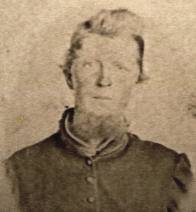 ***
*** 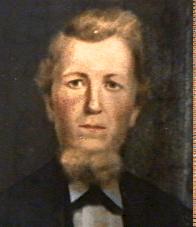
The picture above left is probably the "likeness" referred
to in several
of W.L. Brown’s letters to his wife. The picture to the
right is a photo
of the portrait of W.L. Brown which hangs over the living
room
mantle in the A.R. Brown home in Erwin, Tennessee. It
would appear
that the artist used the soldier photo as the basis for his
painting.
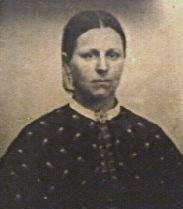
Nancy Colvin Brown, wife of W.L. Brown, probably about the
time
of their wedding
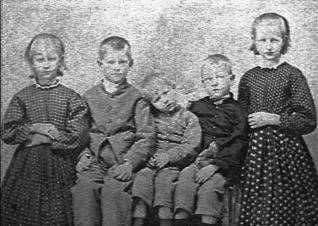
The children of William Laban Brown and Nancy Colvin Brown
From left to right Mary Melissa, John Judson, Albert
Rosecrans,
William Henry and Martha Louisa
Photo c. 1865-1866 by T.H. Smiley's Photographic Gallery,
Knoxville, Tennessee
After the death of their father on the Sultana the children
were placed in
the National Soldiers' and Sailors' Orphan Home in
Washington, D.C. All except
Albert Rosecrans and William Henry died of tuberculosis in
their late teens
or early twenties.
Albert Rosecrans Brown's name was suggested in a letter from
his father. The "Rosecrans"
part is certainly in honor of William S. Rosecrans,
Major General in charge of
volunteers for the Union army. I strongly suspect that
the "Albert" is in honor
of Major Albert C. Catlett, referred to as "a fine man" by
W.L. Brown in
his letters. Major Catlett died of smallpox and the
camp near Nashville
where W.L. Brown spent much of his tour of duty was renamed
"Camp Catlett"
in his honor.
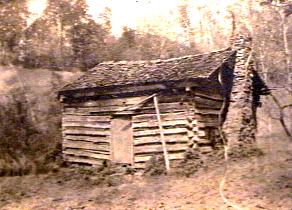
Above: Cabin of William Laban Brown and Nancy Colvin Brown
in Knox County,
Tennessee, where my maternal grandfather Albert Rosecrans
Brown was born
Below: Map of Knoxville and the Cumberland
River. The small house icon shows
the approximate location of the William Laban Brown home near
Twin Creek.
Note also Mount Olive, slightly above and to the left of the
house icon, location
of the Mount of Olives Baptist Church and Cemetery where a
Sultana Memorial
Monument was erected in 1916. W.L. Brown often
addressed his letters
to his wife "Mrs. N.C. Brown, Knoxville, Tennessee, South of
the River".
The Brown home and farm were about four and a half miles
south of the
Cumberland River where it passes Knoxville.
Click
here or on small map above to see a more detailed version.
(Then use your browser's back arrow to return to
this page)
The letters, saved by his widow Nancy Colvin Brown and provided to me to copy by her granddaughter Jodie Brown (daughter of Albert Rosecrans Brown), were mostly from W.L. to his wife and to his parents John (Jhon) and Mary ("Polly") and his brothers and sisters. One letter from Nancy Colvin Brown to W.L. Brown survives because it never reached him and was returned to her after his death on the Sultana.
William Laban Brown was a private in company B of the third Tennessee cavalry (Union) and David Cusick a private in company H. They were most likely taken prisoner when the confederate forces under Nathan Bedford Forrest forced the surrender of the Union fort at Athens, Alabama (where 571 Union soldiers surrendered) and the nearby Sulphur Branch railroad trestle fortification where an additional 400 soldiers (all with the Union 3rd Tennessee Cavalry) surrendered on September 24-25, 1864. These prisoners were then taken to the Cahaba prison camp on the Alabama River 12 miles from Selma. After what must have been a truly horrible experience there they were moved to a parole camp (Camp Fisk or Four Mile Camp) about 4 miles from Vicksburg, Mississippi to await transport to Camp Chase near Columbus, Ohio where they would receive their official discharge from the Union army (a trip requiring both river transportation on the Mississippi and a train trip on into Columbus). Much of this information is from the excellent book The Sultana Tragedy: America’s Greatest Maritime Disaster by Jerry O. Potter, Pelican Publishing Company, Gretna, 1992.
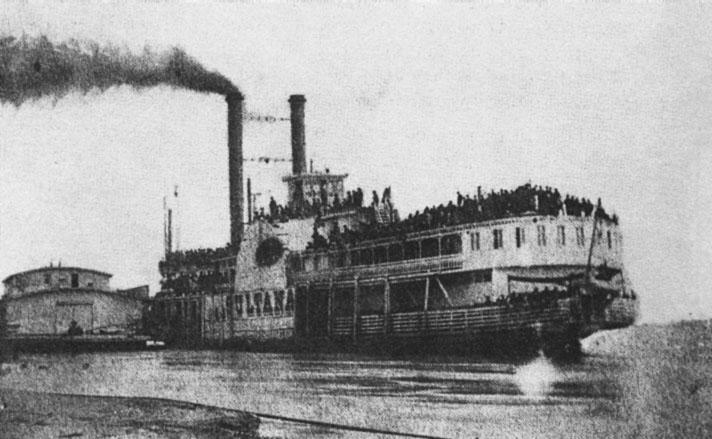
Photograph of the horribly overloaded Mississippi steamship Sultana made at Helena, Arkansas on April 26, 1865, the day before the ship exploded a few miles north of Memphis, Tennessee killing more people than died on the Titanic. From the book The Sultana Tragedy: America’s Greatest Maritime Disaster by Jerry O. Potter, Pelican Publishing Company, Gretna, 1992, p, 72.
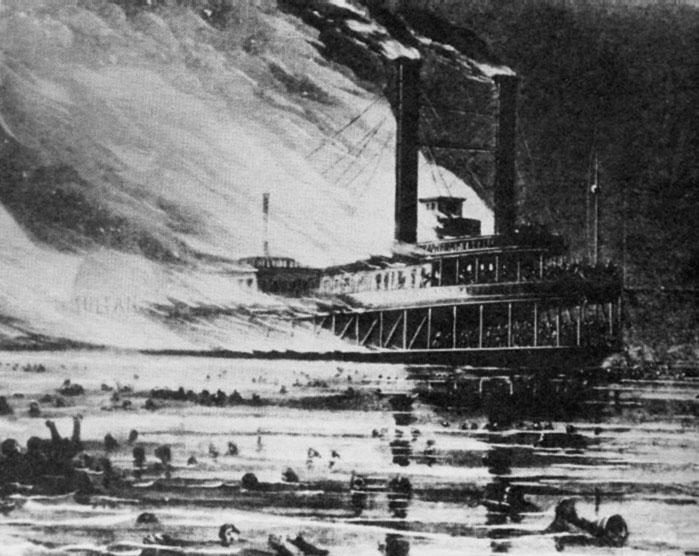
An artist’s drawing of the Sultana disaster (Harpers Weekly) from the book The Sultana Tragedy: America’s Greatest Maritime Disaster by Jerry O. Potter, Pelican Publishing Company, Gretna, 1992, p. 82.
Clues to some of the people mentioned in the
letters:
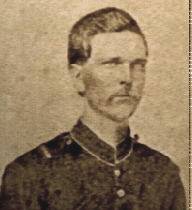 ***
*** ***
***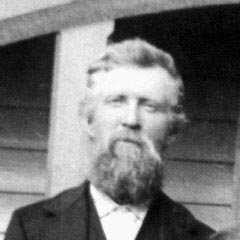
Above, left: Gilbert Crittendon (or Crittleton) Brown,
brother of William Laban Brown, referred to as "Crit" or
"G.C." in the letters. Above center: John Madison Brown,
brother of W.L. Brown (probably the "Mat" referred to in the
letters). Above, right: Hamilton M. Brown, another
brother of W.L. Brown, who was referred to as "Ham" in the
letters. He was only 15 or 16 years old at the time the
letters were written and was at home with his parents, along
with his brothers James Rogers Brown and Robert B. Brown.
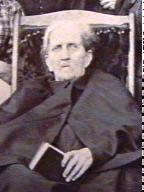 ***
*** 
Above, left: Mary "Polly" Gossett Brown, mother of
William Laban Brown.
Above, right: Benjamin Brown, father of Nancy Colvin
Brown
Click
here or on the preview picture above to see a larger
version.
(Then use your Browser's back arrow to return to
this page.)
Above: Picture made at a family reunion held at the home of
Hamilton Brown, probably
in the early 1890's. Seated in the wheelchair is Mary
"Polly" Gossett Brown, mother of
Hamilton (and William Laban) Brown. Behind her in
the black dress with the shiny trim is
Nancy Colvin Brown, widow of William Laban Brown.
Hamilton
Brown is the tall gentleman
to the left at the back of the picture. In front of him
in the checked dress is his sister
Harriet Elizabeth Brown (Mrs. John Quaid). The man to
the right in the back is Henry
Davis and the woman next to him possibly Margaret Ann Brown,
sister of Hamilton
Brown. The remaining woman may be Judith Katheryn
Tarwater,
wife of Robert B. Brown (a brother of Hamilton Brown).
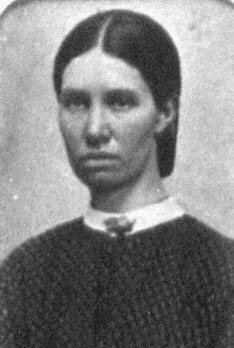
The children of William Laban Brown and Nancy Colvin Brown were Martha Louisa (22 Oct 1856 - 29 Mar 1875), Mary Melissa (4 Mar 1858 - 27 Mar 1871), John Judson (25 Sep 1859 - 20 Aug 1877), William Henry (1 Aug 1861 - 25 Jul 1934) and Albert Rosecrans (7 Jul 1863 - 29 May 1937). The oldest four were about ages 7, 5, 4 and 2 years when W.L. Brown left for the war and the youngest (my grandfather) was born almost exactly nine months after his father left for the army and was probably named for Major Albert C. Catlett and Major General William S. Rosecrans. In his letters W.L. Brown refers to his children as Marthey, Mary, Juddy (which he spells Judy in all but one letter), Willy (which he spells Wiley) and little Albert. He often speaks of Mat and Crit, almost certainly referring to his younger brothers in the army. He mentions Mat's wife "Sary": Sara Hitch was the wife of John Madision Brown.
W.L. Brown mentions several times that he misses the preaching of "Brother Hines", probably pastor of the Mount of Olives church in Knox County, Tennessee. It is likely that pastor Hines had a son in the army, Josh Hines, and W.L. several times says "…tell Brother Hines that Josh Hines is well". Listed among the survivors of the Sultana tragedy is a Samuel J. [Joshua?] Hines, private, Co. B, 5th Infantry.
Other soldiers he reports on include Anderson Davis, Boyd Sharp, Wade Johnson, Mat Rodgers (possibly a relative) and he reports the deaths of Carson Anderson [could this be Anderson F. Carson of Co. F?], James McClanihan, John Rodgers, (Isaac?) Price, Jonathan Houser and others including a Shane MacCullie reported as drowned.
The term "Butternuts" shows up a few times in the letters - this seems to refer to local confederates or confederate sympathizers. In addition to the gray uniforms of the Confederacy there were some wearing brown homespun uniforms which took their color from the butternut used in dying the cloth.
Click on the small pictures below to see larger
versions
(and then use your browser's back arrow to
return to this page).
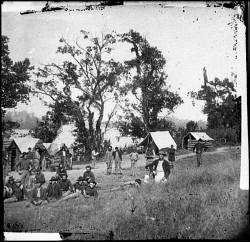 Federal
troops camped by the Tennessee River near Chattanooga
Federal
troops camped by the Tennessee River near Chattanooga
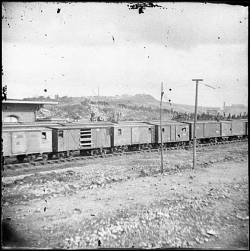 Federal
Cavalry guarding the train depot near Chattanooga, Tennessee
Federal
Cavalry guarding the train depot near Chattanooga, Tennessee
Letter written by Nancy Colvin Brown to William Laban Brown with entries on May 2, 4, and 5, 1865. The letter was returned to her since, unknown to her at the time, he had already died on the Sultana on April 27, 1865. Below are photographs of the letter, followed by my best effort at transcribing it.
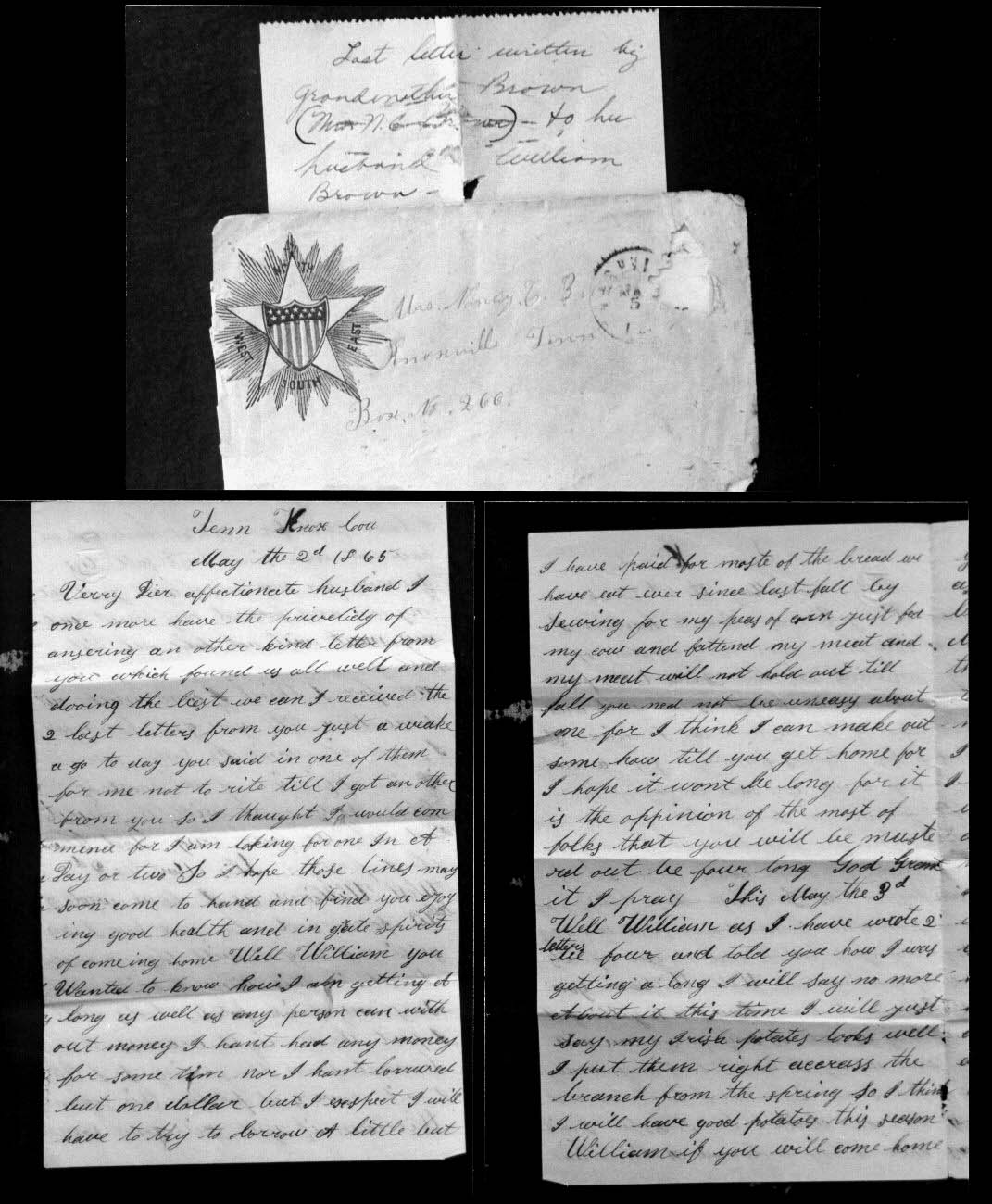
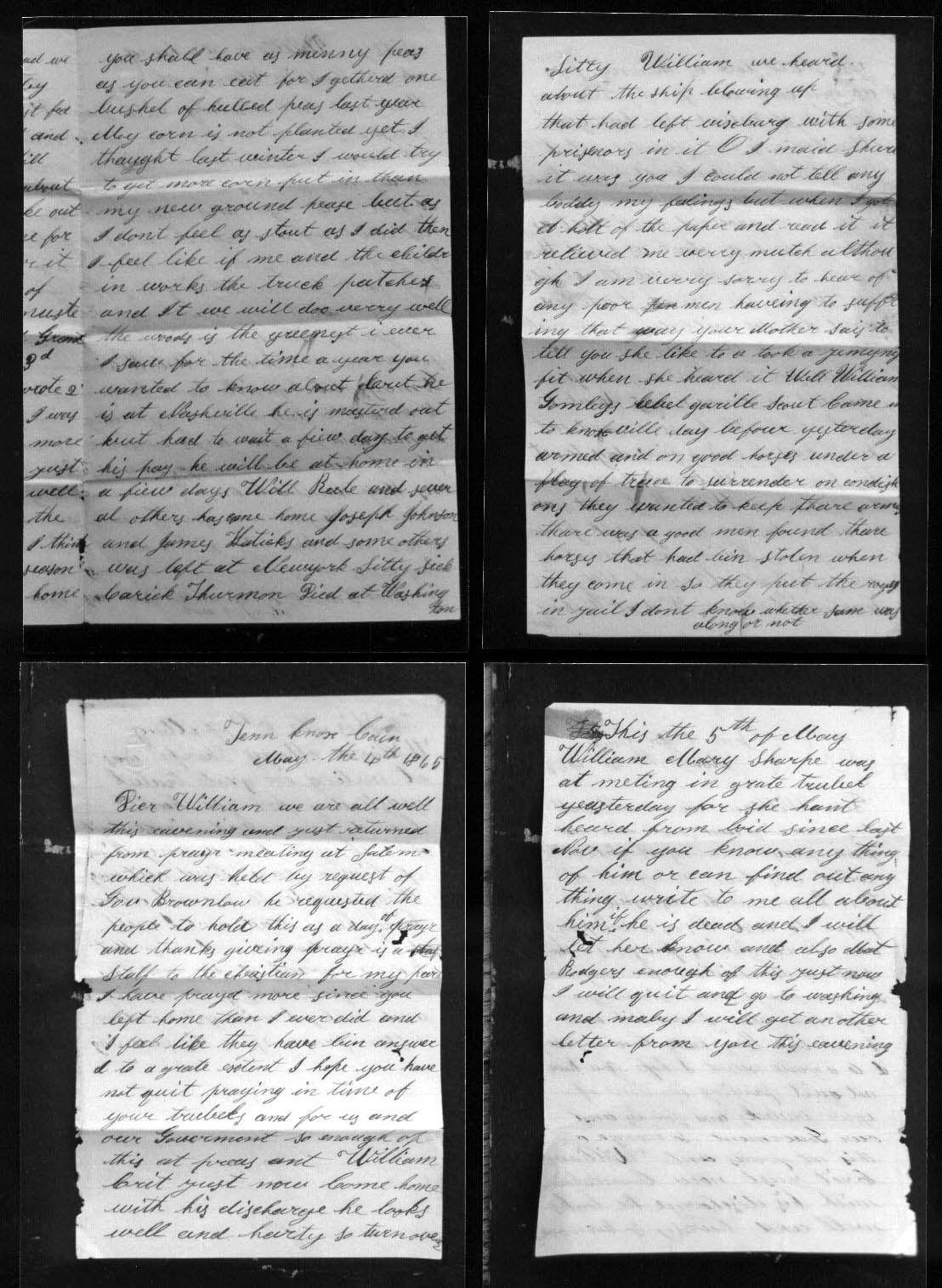
Last Update August 24, 2018